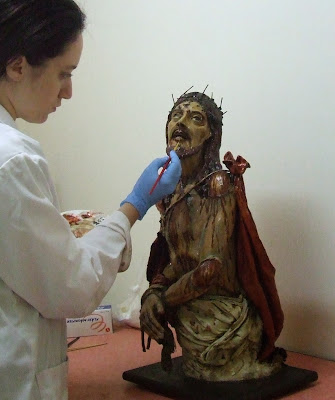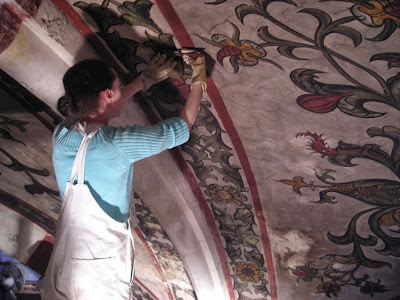The canvas painting before and after the conservation- restoration treatments.
This beautiful painting is a reproduction of another by the same
subject, executed in the early 1620s by the Spanish artist, Jusepe de Ribera (1591-1652).
Ribera’s painting, currently situated at the National Gallery in London, was
influenced by the style of Caravaggio.
Continue reading about the conservation treatments of this painting and its decorative frame, below:
Manufacturing Technique:
The painting is stretched on a stretcher frame. It appears that the original canvas is fairly
thin, having a closed weave and being quite textured. It could be deduced that the material used for the support is probably
cotton or linen. The painting seems to have a very thin preparatory layer, which
is dark brown in colour. The medium used is probably oil, while the surface of the paint layer is textured,
with areas having high impasto.
Visual observations deduced the presence of a very thick
and dark varnish layer. Investigations using
ultra violet light resulted in a green fluorescence thus confirming the
presence of this stratum as being of organic material.
Past Restorations and State of Conservation:
The painting was lined in the past. Observations indicate that this
restoration was carried out fairly recently, most probably in the past ten
years. The lining canvas is still fulfilling its
purpose in supporting the original canvas.
A general photograph of the
verso of the canvas painting, showing the lining canvas.
The preparatory and paint layers have suffered from
extensive damage in the past. The paint layer is abraded in turn exposing the
underlying canvas weave. It can be hypothesized that the painting has suffered
damage during the lining procedure which was carried out during the past
restoration intervention, due to a high heat used.
Abrasions of the paint
layer around and on Jesus Christ’s hand.
Under investigations using ultra violet light,
old retouchings and overpainting were observed giving off a black fluorescence.
The varnish layer present had oxidised into a dark, brown
layer which was obscuring heavily the paint layer, and interfering with the
aesthetic quality of the painting.
Conservation-Restoration Treatments:
Cleaning of the paint layer
The painting was temporarily un-mounted from the decorative frame.
The varnish and old retouchings proved to be stubborn to
most of the reagents used during the preliminary cleaning tests. Various mixtures of organic solvents had to be used, in some cases rendered in a solvent gel using hydroxypropylcelulose. In some cases, thick encrustations were
removed using a scalpel blade.
During the removal of varnish from the paint
layer.
Infilling of lacunae
The minor losses in the preparatory and paint layers, were infilled with a
prepared mixture of Gesso di Bologna (calcium sulfate) and Rabbit-skin
Glue. The infills were then
levelled down to the surface of the painting using a scalpel blade.
Pictorial Reintegration
The painting was given a layer of a synthetic varnish, which has two main functions i.e. that of saturating the colours, and acting as an
intermediate layer between the paint layer and the successive retouching
intervention.
Pictorial reintegration was subsequently carried out on
lacunae and on the abrasions of the paint layer, using reversible varnish colours.
During the process of pictorial reintegration.
Final protective layer
A thin, synthetic and
reversible protective coating was applied in spray form, to primarily protect the surface from any future mechanical
damage and foreign deposits accumulation.
Treatments of the Decorative Frame
The decorative frame was surface cleaned
from the accumulated dust and grime. Any cracks and lacunae present were then
consolidated using an organic adhesive. The cracks and
other lacunae were infilled using a mixture of Gesso di Bologna (calcium
sulfate) and Rabbit-skin Glue using a spatula. These infills were then
levelled down to the surface of the frame or else carved following the design.
During
the process of surface cleaning of the decorative frame.
Since the decorative frame was originally commercially gilded, the infills were then reintegrated using
a liquid metal which does not tarnish with
time. The decorative frame was finally given a protective coating of synthetic
varnish in spray form.
The painting was then re-mounted inside the decorative frame.
The painting was then re-mounted inside the decorative frame.
Images and text are copyright Sarah Yeomans Gafa` 2016.



































